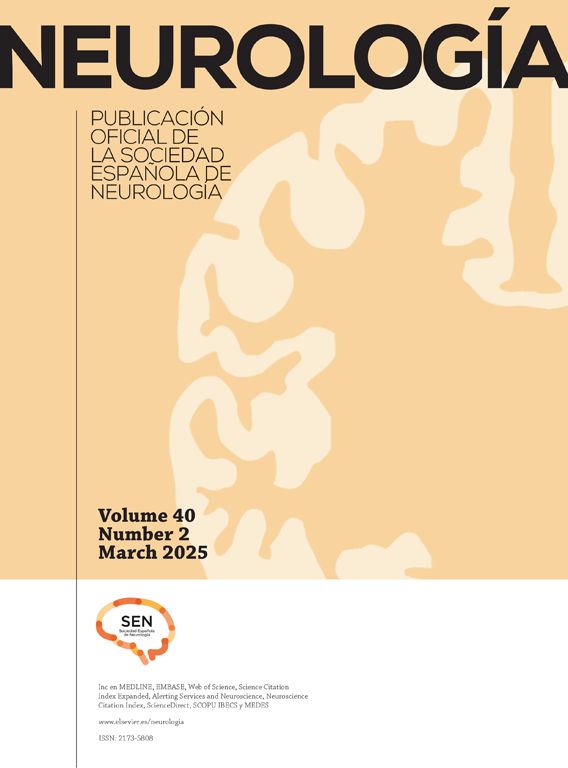Lingual dystonia is a type of focal dystonia, and more specifically a subtype of oromandibular dystonia characterised by repetitive movements of the muscles of the tongue. The most frequently described movement is tongue protrusion.1,2 This is a rare type of dystonia: the case series by Esper et al.3 reported a prevalence of 4% among all the types of dystonia assessed. However, it is associated with significantly decreased quality of life, and may cause limitations to such daily activities as eating or speaking.4 Furthermore, response to oral treatments may be partial and limited.4 For these reasons, botulinum toxin may be considered the treatment of choice, and its use has been described in case series and some isolated case reports.4–9 Regarding its safety, relevant adverse reactions include dysarthria, dysphagia, and even difficulty breathing and aspiration pneumonia, which may limit its use.8,9
We performed a retrospective review of a case series of 6 patients diagnosed with lingual dystonia and under follow-up by the movement disorders unit of a tertiary hospital, who had received botulinum toxin type A infiltrations (onabotulinumtoxinA and incobotulinumtoxinA).
Median age in our series was 60 years (Q1–Q3: 48.75–74.25). Five patients were women, and no patient presented history of any neurological disease. Regarding type of dystonia, 4 out of the 6 patients had focal dystonia. One presented generalised dystonia and another also presented writer’s cramp, and was therefore considered to present multifocal dystonia. As in other reported series, the most frequent type of movement was tongue protrusion, which was observed in all patients. Furthermore, 2 patients also presented tongue torsion and lateralisation. Four patients also displayed a component of oromandibular dystonia, with opening and lateralisation of the jaw (Fig. 1). Three patients presented other associated movement disorders: parkinsonism in 2 patients and head and upper limb postural tremor in one.
Aetiology of dystonia was very diverse: primary in 2 cases, genetic in one patient (ATP1A3 mutation, causing DYT12 or rapid-onset dystonia-parkinsonism), neurodegenerative due to multiple system atrophy in one, due to tardive syndrome in one, and functional in the remaining patient.
Botulinum toxin infiltration was guided by ultrasound in 4 patients and by both ultrasound and electromyography in one patient. In only one patient, administration was anatomically guided. Botulinum toxin infiltrations were performed every 3 months in all patients. The median maximum dose of botulinum toxin used in the affected oromandibular muscles was 45 units (Q1–Q3: 25–53.75). Botulinum toxin was infiltrated to the genioglossus muscle in 4 patients, and to the hyoglossus muscle via the submandibular route in one patient. The remaining patient underwent intraoral infiltration to the intrinsic muscles of the tongue, specifically the transverse muscle.
In those patients presenting dystonia with opening and lateralisation of the jaw, other oromandibular muscles were infiltrated, including the digastric muscle (3 patients), pterygoid muscles (2 patients), mylohyoid muscle (2 patients), masseter muscles (2 patients), and platysma (one patient).
The median degree of subjective improvement was 60% (Q1–Q3: 12.5%–70%) and the median duration of the effect amounted to 1.5 months (Q1–Q3: 0–2.5). Two patients presented mild, transient adverse reactions, consisting of dysarthria and dysphagia. We did not observe severe or permanent adverse reactions in any case.
In conclusion, lingual dystonia is a subtype of dystonia secondary to very diverse aetiologies, and presents little response to pharmacological treatment.4 Botulinum toxin may be a safe and effective treatment for lingual dystonia. In our series, the median degree of improvement was above 50% and adverse reactions were mild, transient, and infrequent. We consider that the performance of ultrasound- and electromyography-guided infiltration may be fundamental in improving the safety of the treatment. The main limitation of our case series is its small size, and further prospective studies with larger sample sizes are needed to study factors influencing the effectiveness of treatment and to establish therapeutic protocols.
FundingThis study has received no funding.







